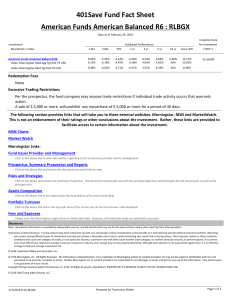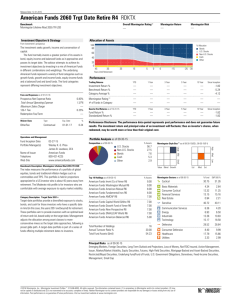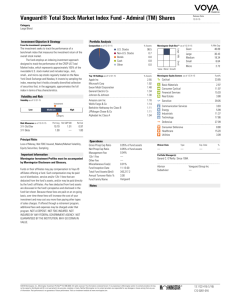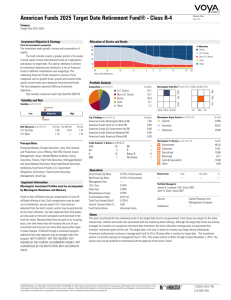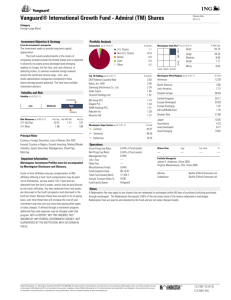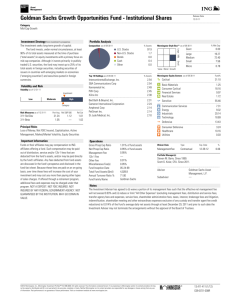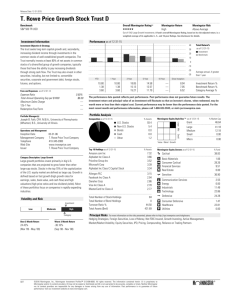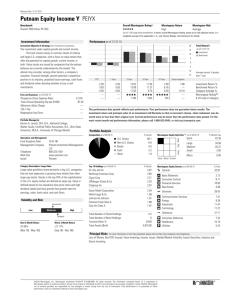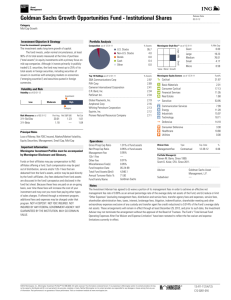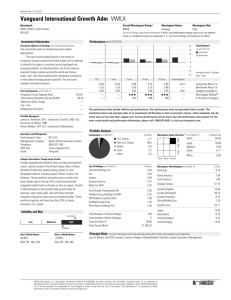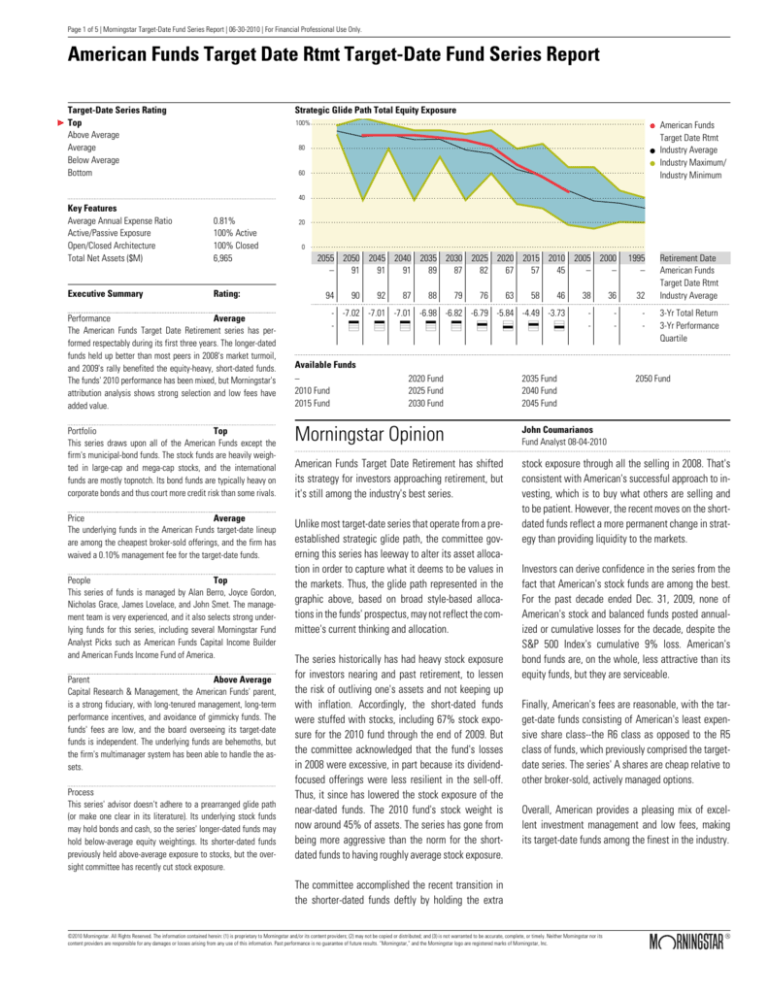
Page 1 of 5 | Morningstar Target-Date Fund Series Report | 06-30-2010 | For Financial Professional Use Only.
American Funds Target Date Rtmt Target-Date Fund Series Report
Target-Date Series Rating
Top
Above Average
Average
Below Average
Bottom
Strategic Glide Path Total Equity Exposure
100%
100
American Funds
Target Date Rtmt
Industry Average
Industry Maximum/
Industry Minimum
80
80
60
60
40
40
Key Features
Average Annual Expense Ratio
Active/Passive Exposure
Open/Closed Architecture
Total Net Assets ($M)
0.81%
100% Active
100% Closed
6,965
Executive Summary
Rating:
Performance
Average
The American Funds Target Date Retirement series has performed respectably during its first three years. The longer-dated
funds held up better than most peers in 2008's market turmoil,
and 2009's rally benefited the equity-heavy, short-dated funds.
The funds' 2010 performance has been mixed, but Morningstar's
attribution analysis shows strong selection and low fees have
added value.
Portfolio
Top
This series draws upon all of the American Funds except the
firm's municipal-bond funds. The stock funds are heavily weighted in large-cap and mega-cap stocks, and the international
funds are mostly topnotch. Its bond funds are typically heavy on
corporate bonds and thus court more credit risk than some rivals.
Price
Average
The underlying funds in the American Funds target-date lineup
are among the cheapest broker-sold offerings, and the firm has
waived a 0.10% management fee for the target-date funds.
People
Top
This series of funds is managed by Alan Berro, Joyce Gordon,
Nicholas Grace, James Lovelace, and John Smet. The management team is very experienced, and it also selects strong underlying funds for this series, including several Morningstar Fund
Analyst Picks such as American Funds Capital Income Builder
and American Funds Income Fund of America.
Parent
Above Average
Capital Research & Management, the American Funds' parent,
is a strong fiduciary, with long-tenured management, long-term
performance incentives, and avoidance of gimmicky funds. The
funds' fees are low, and the board overseeing its target-date
funds is independent. The underlying funds are behemoths, but
the firm's multimanager system has been able to handle the assets.
Process
This series' advisor doesn't adhere to a prearranged glide path
(or make one clear in its literature). Its underlying stock funds
may hold bonds and cash, so the series' longer-dated funds may
hold below-average equity weightings. Its shorter-dated funds
previously held above-average exposure to stocks, but the oversight committee has recently cut stock exposure.
20
20
00
2055 2050 2045 2040 2035 2030 2025 2020 2015 2010 2005 2000
–
91
91
91
89
87
82
67
57
45
–
–
94
90
46
38
36
32
- -7.02 -7.01 -7.01 -6.98 -6.82 -6.79 -5.84 -4.49 -3.73
&
&
&
&
&
*
(
*
(
-
-
-
Available Funds
–
2010 Fund
2015 Fund
92
87
88
79
76
2020 Fund
2025 Fund
2030 Fund
63
58
1995
–
2035 Fund
2040 Fund
2045 Fund
Retirement Date
American Funds
Target Date Rtmt
Industry Average
3-Yr Total Return
3-Yr Performance
Quartile
2050 Fund
Morningstar Opinion
John Coumarianos
Fund Analyst 08-04-2010
American Funds Target Date Retirement has shifted
its strategy for investors approaching retirement, but
it's still among the industry's best series.
stock exposure through all the selling in 2008. That's
consistent with American's successful approach to investing, which is to buy what others are selling and
to be patient. However, the recent moves on the shortdated funds reflect a more permanent change in strategy than providing liquidity to the markets.
Unlike most target-date series that operate from a preestablished strategic glide path, the committee governing this series has leeway to alter its asset allocation in order to capture what it deems to be values in
the markets. Thus, the glide path represented in the
graphic above, based on broad style-based allocations in the funds' prospectus, may not reflect the committee's current thinking and allocation.
The series historically has had heavy stock exposure
for investors nearing and past retirement, to lessen
the risk of outliving one's assets and not keeping up
with inflation. Accordingly, the short-dated funds
were stuffed with stocks, including 67% stock exposure for the 2010 fund through the end of 2009. But
the committee acknowledged that the fund's losses
in 2008 were excessive, in part because its dividendfocused offerings were less resilient in the sell-off.
Thus, it since has lowered the stock exposure of the
near-dated funds. The 2010 fund's stock weight is
now around 45% of assets. The series has gone from
being more aggressive than the norm for the shortdated funds to having roughly average stock exposure.
Investors can derive confidence in the series from the
fact that American's stock funds are among the best.
For the past decade ended Dec. 31, 2009, none of
American's stock and balanced funds posted annualized or cumulative losses for the decade, despite the
S&P 500 Index's cumulative 9% loss. American's
bond funds are, on the whole, less attractive than its
equity funds, but they are serviceable.
Finally, American's fees are reasonable, with the target-date funds consisting of American's least expensive share class--the R6 class as opposed to the R5
class of funds, which previously comprised the targetdate series. The series' A shares are cheap relative to
other broker-sold, actively managed options.
Overall, American provides a pleasing mix of excellent investment management and low fees, making
its target-date funds among the finest in the industry.
The committee accomplished the recent transition in
the shorter-dated funds deftly by holding the extra
©2010 Morningstar. All Rights Reserved. The information contained herein: (1) is proprietary to Morningstar and/or its content providers; (2) may not be copied or distributed; and (3) is not warranted to be accurate, complete, or timely. Neither Morningstar nor its
content providers are responsible for any damages or losses arising from any use of this information. Past performance is no guarantee of future results. “Morningstar,” and the Morningstar logo are registered marks of Morningstar, Inc.
Page 2 of 5 | Morningstar Target-Date Fund Series Report | 06-30-2010 | For Financial Professional Use Only.
American Funds Target Date Rtmt Target-Date Fund Series Report
Performance
Rating:
Average
The American Funds target-date funds boast some of
the best underlying stock funds in the business, but
the longer dated funds have generally outperformed
their peer groups while the shorter dated funds
haven't. This series used to get more equity-heavy relative to the peer-group norm as investors near and
pass retirement. American Funds Target Date 2010,
which had roughly 67% of its assets in equities versus a 50% norm, gained more than 23% in 2009.
However, the short dated funds struggled mightily in
2008, and the funds' oversight committee has now reduced the amount of stock exposure in the shorter dated funds. So, the 2010 fund, for example, now has
45% equity exposure. This is likely a permanent risk
reduction. Although the committee thinks maintaining significant stock exposure for early retirees is important, it also recognizes that early retirees can handle only so much volatility. Over the life of Target
Date 2010, however, from Feb. 2, 2007, through June
30, 2010, the fund has underperformed its peer group
because of its rocky 2008 performance.
tion, Target Date 2045 also eked out a victory over its
category's 31% return during 2009's rally with a
31.6% return. Cash in the longer-dated funds also
has helped in downdrafts, and it hasn't hurt in recent
rallies.
The series' bond funds, such as American Funds Bond
Fund of America, suffered mightily in 2008, when only U.S. Treasuries rallied. Those funds typically have
avoided Treasuries (though they may lean on them
more in the future) and sought to add value with corporate bonds that its credit analysts believe are mispriced. This strategy fared much better in 2009, as investors' appetite for risk has increased.
The longer-dated funds have done better relative to
their peers. Target Date 2045, for example, has dropped 14% over its existence through June 30, 2010,
while the Target Date 2041-2045 category average is
a 21% loss. Thanks in part to American's stock selec-
Target-Date Fund Performance as of 06-30-2010
American Funds Trgt Date Ret 2010 A
American Funds Trgt Date Ret 2015 A
American Funds Trgt Date Ret 2020 A
American Funds Trgt Date Ret 2025 A
American Funds Trgt Date Ret 2030 A
YTD
Return %
-1.7
-3.2
-4.3
-5.7
-6.4
2009
Return %
23.3
24.6
26.8
29.4
31.1
2008
Return %
-27.5
-29.1
-32.5
-34.8
-35.2
3-Yr
Return %
-3.7
-4.5
-5.8
-6.8
-6.8
3-Yr % Rank
in Cat
70
48
60
38
24
3-Yr
Std Dev
14.4
15.5
17.0
18.4
18.9
5-Yr
Return %
–
–
–
–
–
5-Yr % Rank
in Cat
–
–
–
–
–
American Funds Trgt Date Ret 2035 A
American Funds Trgt Date Ret 2040 A
American Funds Trgt Date Ret 2045 A
American Funds Trgt Date Ret 2050 A
American Funds Trgt Date Ret 2055 A
-6.6
-6.8
-6.8
-6.8
–
31.3
31.6
31.5
31.6
–
-35.5
-35.6
-35.6
-35.6
–
-7.0
-7.0
-7.0
-7.0
–
18
8
15
3
–
19.2
19.3
19.3
19.3
–
–
–
–
–
–
–
–
–
–
–
Star
Rating
QQ
QQ
QQ
QQ
QQQ
QQQ
QQQ
QQQ
QQQQ
–
For peer comparisons, 1 = highest return or lowest risk, 100 = lowest return or highest risk.
Target Date Funds Risk-Adjusted Returns +/- Category Average
Data as of 06-30-2010
Attribution Analysis
Trailing 3-Year Returns as of 06-30-2010
7.8%
0.81
Total
0.70
Selection
Cost
Glide Path
5.2
2.38
2.03
-0.32
2.6
0
0.08
-1.21
-3.5
-7.0
-10.
5
-3.22
2055
2050
2045
2040
2035
2030
2025
2020
2015
2010
2005
2000
Risk-adjusted return exceeding category average
Risk-adjusted return trailing category average
Category Average
Data is based on longest available performance history: three or five years. For series with more than 18 months of history, but less than three years of
history, the risk-adjusted return of the appropriate Morningstar Lifetime Moderate Index is used to create a 3-year history.
-0.56
1995
Glide Path
Cost
Selection
Total
©2010 Morningstar. All Rights Reserved. The information contained herein: (1) is proprietary to Morningstar and/or its content providers; (2) may not be copied or distributed; and (3) is not warranted to be accurate, complete, or timely. Neither Morningstar nor its
content providers are responsible for any damages or losses arising from any use of this information. Past performance is no guarantee of future results. “Morningstar,” and the Morningstar logo are registered marks of Morningstar, Inc.
-5.12
-8.69
American Funds Target Date Rtmt
-1.21
0.08
0.81
-0.32
Page 3 of 5 | Morningstar Target-Date Fund Series Report | 06-30-2010 | For Financial Professional Use Only.
American Funds Target Date Rtmt Target-Date Fund Series Report
Portfolio
Rating:
Top
Series Holding-based Style Map - Equity
Data as of 06-30-2010
Giant
big that it's difficult for them to gain significant exposure to mid-caps and small caps.
Large
Lately, the firm has revamped its core bond offering
Bond Fund of America. Although the firm brings formidable expertise to credit analysis, its managers and
analysts arguably held on to lower-grade bonds too
long in 2008 when spreads (the difference in yield between high-grade and low-grade bonds) narrowed considerably. Bond Fund of America now has a tamer
look, owing to a permanent stake in U.S. Treasuries.
Mid
Small
Micro
Nine of the underlying funds in American's targetdate series are Morningstar Fund Analyst Picks, including American Funds Balanced, American Funds Income Fund of America, Capital Income Builder, American Funds AMCAP, American Funds Fundamental Investors, American Funds Washington Mutual Investors, American Funds New Perspective, American
Funds EuroPacific Growth, and American Funds New
Economy. No other target-date lineup boasts nearly
as many Analyst Picks. All of American's stock funds
posted positive returns for the trailing decade
through the end of 2009, owing to the firm's superior
analyst staff and long-term perspective. The underlying stock funds benefit from the firm's deep stock-selection prowess, and its expertise in corporate bonds
is also formidable. All of the firm's funds are managed by multiple portfolio managers, which helps it
deal with the huge asset bases of the underlying
funds. On the downside, the firm's stock funds are so
DeepValue
CoreCore
CoreHighValue
Growth Growth
Zone represents 75% of series' largest domestic stock holdings
Fund centroid represents weighted average of series'
domestic stock holdings
The firm also lacks specialty funds in bonds, such as
a dedicated Treasury Inflation-Protected Securities
fund, and it doesn't have a real estate fund. Still, that
fact reflects its refusal to issue funds that it believes
don't stand on their own investment merits or whose
holdings don't constitute discrete asset classes.
Top Investments as of 06-30-2010
American Funds US Government Sec R6
American Funds Washington Mutual R6
American Funds Invmt Co of Amer R6
American Funds American Balanced R6
American Funds American Mutual R6
Category
Intermediate Government
Large Value
Large Blend
Moderate Allocation
Large Value
American Funds Fundamental Invs R6
American Funds Capital Inc Bldr R6
American Funds Inc Fund of Amer R6
American Funds New Perspective R6
American Funds Capital World G/I R6
Large Blend
World Allocation
Moderate Allocation
World Stock
World Stock
% of
Assets
8.61
7.43
6.95
6.90
6.33
3-Yr
Return %
–
–
–
–
–
3-Yr
% Rank
in Cat
–
–
–
–
–
3-Yr
Std Dev
–
–
–
–
–
5-Yr
Return %
–
–
–
–
–
5-Yr
% Rank
in Cat
–
–
–
–
–
Morningstar
Risk
------
Star
Rating
WWW
WWWW
WWWW
WWWW
WWWWW
5.94
5.75
5.73
5.67
5.22
–
–
–
–
–
–
–
–
–
–
–
–
–
–
–
–
–
–
–
–
–
–
–
–
–
------
WWWW
WWWW
WWWW
WWWW
WWWWW
Total # Holdings
% Portfolio in Top 10 Holdings
Overall Average Morningstar Rating
Price
21
64.52
3.93
Rating:
Average
Although Capital Research & Management recently
has raised fees on all of the American Funds, they remain among the cheapest broker-sold funds in the industry. The sheer amount of assets the firm runs
helps keep prices down, as larger funds can offer
economies of scale to shareholders. The firm has created separate retirement (R6) share classes of its un-
derlying funds to create the A share class of its targetdate lineup, and those A shares remain among the
least expensive in the industry. Share classes that
have American handle administrative duties for
401(k) plans, including R2 and R3, are considerably
more expensive.
Cost vs. Industry Average
American Funds Target Date Rtmt A
Industry Average
Avg Cost Per Share Class
A
R3
R2
R4
R5
©2010 Morningstar. All Rights Reserved. The information contained herein: (1) is proprietary to Morningstar and/or its content providers; (2) may not be copied or distributed; and (3) is not warranted to be accurate, complete, or timely. Neither Morningstar nor its
content providers are responsible for any damages or losses arising from any use of this information. Past performance is no guarantee of future results. “Morningstar,” and the Morningstar logo are registered marks of Morningstar, Inc.
0.81%
0.88%
Exp Ratio (%) Net Assets ($M)
0.81%
2,620
1.16%
1,589
1.54%
1,569
0.85%
756
0.55%
291
Page 4 of 5 | Morningstar Target-Date Fund Series Report | 06-30-2010 | For Financial Professional Use Only.
American Funds Target Date Rtmt Target-Date Fund Series Report
People
Rating:
Top
Management: Veteran portfolio managers Alan Berro, Joyce Gordon, Nicholas Grace, James Lovelace,
and John Smet run sleeves of the American Funds target-date funds. They have 23 years of tenure at the
firm on average. Few, if any, target-date lineups
boast such formidable and experienced management.
Smet is a fixed-income specialist, while Grace is listed as a manager on American Funds EuroPacific
Growth. Berro, Gordon, and Lovelace are listed on a
variety of the firm's domestic, foreign, and allocation
funds. American is noted for its rigorous hiring process and views its relationships with employees as marriages. It hires the best people it can find and stays
with them for the longer haul.
Series Management
best practice in the mutual fund world. This keeps
them focused on their long-term results. Stock portfolios tend to average 20%-25% turnover, which
means managers tend to hold stocks for four to five
years on average. The compensation incentives allow
the managers to have the courage of their convictions and stick with stocks that they think are undervalued until the market recognizes what they've already noticed. The managers also accumulate ownership of the advisor throughout their careers. Regarding investments in the funds, Berro and Gordon have
between $100,000 and $500,000 in American's targetdate series, while Lovelace, Grace, and Smet have
less than $50,000 in the funds (though the managers
are heavily invested in the underlying funds).
Manager
James B. Lovelace
John H. Smet
Alan Berro
Joyce E. Gordon
Nicholas Grace
Start Date
02-2007
02-2007
02-2007
02-2007
02-2007
Average Tenure
Longest Tenure
Target-Date Industry
Average Tenure
3.5 years
3.5 years
4.6 years
Underlying Funds' Management
Average Tenure
12.1 years
Longest Tenure
39.4 years
Mutual Fund Industry
Average Tenure
5.1 years
Manager Incentives: American Funds portfolio managers are paid on four- and eight-year performance, a
Parent
Rating:
Above Average
Corporate Culture: Capital Research & Management, the parent of American Funds, is among the asset-management industry's finest stewards of capital. The firm seeks to hire investment professionals
for life. It succeeds so well at that goal that no other
firm boasts as many investment professionals with
multidecade careers at the same place. Capital's analysts and fund managers have unmatched experience.
The firm doesn't issue gimmicky funds based on hot,
but ephemeral, asset classes or industries. Conversely, it dedicates resources to efforts that are not remunerative for decades if they have investment merit,
such as the firm did with international investing starting in the 1950s. Its four- and eight-year compensation structure for analysts and managers allows them
to maintain the courage of their convictions and stick
with underpriced stocks until the market recognizes
their value.
Board Oversight: American Funds' target-date series is governed by an independent board of directors,
six of whom were new to the board on Jan. 1, 2010.
Twelve of the board's 14 trustees are independent,
as is the chairman. However, only six of the 12 independent directors invest more in the funds they oversee than they receive in annual compensation. The
Fund Family Data
board is charged with negotiating the funds' expense
ratios, and they've garnered a reasonable fee here.
Transparency: The American Funds' website offers
good information on its target-date lineup, especially
on the fund-level pages. Investors can gain access to
each fund's breakdown by fund category and underlying fund. There is scant detail, however, on the series' investment rationale and on how to use a targetdate fund. Although many American Funds shareholders work with advisors, who can tailor an individualized asset-allocation plan, the firm could provide
more information on the rationale for the funds and
on the theory behind the glide path. Senior portfolio
managers and executives discuss their views of the
markets in video interviews on the firm's website.
Average Star Rating
% of Assets w/Star Rating
QQQQ
57.7%
Assets
(listed in USD $Mil)
Mutual Fund Assets
ETF Assets
Other Assets
Total Assets ($M)
Number of Funds
103,212
0
19,943
123,156
65
Stewardship Grade Average
Average Manager Tenure
Longest Manager Tenure
5-year Manager
Retention Rate (%)
A
12.6 years
39.4 years
Regulatory History: These funds' advisor previously
paid for inclusion on some brokers' lists of preferred
funds, though the practice was legal at the time. Also, the SEC has not reviewed an appeal that the firm
made regarding a decision by the Financial Industry
Regulatory Authority to fine the firm $5 million for directing brokerage commissions to firms that were top
sellers of its funds.
©2010 Morningstar. All Rights Reserved. The information contained herein: (1) is proprietary to Morningstar and/or its content providers; (2) may not be copied or distributed; and (3) is not warranted to be accurate, complete, or timely. Neither Morningstar nor its
content providers are responsible for any damages or losses arising from any use of this information. Past performance is no guarantee of future results. “Morningstar,” and the Morningstar logo are registered marks of Morningstar, Inc.
98.7%
Page 5 of 5 | Morningstar Target-Date Fund Series Report | 06-30-2010 | For Financial Professional Use Only.
American Funds Target Date Rtmt Target-Date Fund Series Report
Process
Glide Path: This series' advisor doesn't adhere to a
prearranged glide path (unlike many of its peers) so
Morningstar's Glide Path graph may not match its strategic asset allocation. The American Funds targetdate fund with the largest equity allocation, American Funds Target Date Retirement 2050, had 85% of
its assets in stocks as of March 31, 2010, which is a
bit below the Morningstar category norm. American's
stock funds tend to run with some cash and bonds, so
at times, its long-dated funds' equity exposure has
been lower. The series' stock exposure begins to taper off about 15 years before retirement, with American Funds Target Date Retirement 2010 having roughly 45% equity exposure after the firm recently reduced its stock allocation.
Strategic Glide Path Total Equity Exposure
100%
100
American Funds
Target Date Rtmt
Industry Average
Industry Maximum/
Industry Minimum
80
80
60
60
40
40
20
20
00
2055 2050 2045 2040 2035 2030 2025 2020 2015 2010 2005 2000
–
91
91
91
89
87
82
67
57
45
–
–
94
90
92
87
88
79
76
63
58
1995
–
46
38
36
32
- -7.02 -7.01 -7.01 -6.98 -6.82 -6.79 -5.84 -4.49 -3.73
&
&
&
&
&
*
(
*
(
-
-
-
80
60
40
2055 2050 2045 2040 2035 2030 2025 2020 2015 2010 2005 2000
–
53
53
53
52
53
54
59
61
64
–
–
–
10
10
10
10
10
9
7
6
6
–
–
–
29
29
29
29
29
29
28
28
24
–
–
–
7
7
7
8
8
7
5
4
3
–
–
–
1
1
1
1
1
1
1
1
3
–
–
1995
–
–
–
–
–
Retirement Date
U.S. Large Cap
U.S. Mid/Small Cap
Non-U.S. Developed
Non-U.S. Emerging
Other
Fixed-Income Allocation
100%
TIPS
U.S. Government
U.S. Investment
Grade
U.S. High Yield
Foreign
Cash
Other
80
60
40
Fixed Income %
Rationale: American's portfolio-oversight committee
reserves the right to shift the funds' asset allocation
rather than sticking to a prearranged glide path. In
less able hands, that approach would cause greater
concern. Yet the firm's multiple portfolio counselor
system, where managers oversee sleeves of the underlying funds, is time-tested and has proved highly
successful. The target-date portfolio managers also
manage sleeves of the underlying funds, reinforcing
our confidence that the team has its finger on the
pulse of the target-date funds' asset-allocation policy.
U.S. Large Cap
U.S. Mid/Small Cap
Non-U.S. Developed
Non-U.S. Emerging
Other
Equity %
The funds favor large- and mega-cap stocks over
small- and mid-caps, a likely side effect of the underlying funds' massive asset bases. Despite the firm's
credit expertise, this series doesn't take inordinate
risks on the bond side. The American Funds Target
Date Retirement 2035 Fund has 79% of its fixed-income assets in securities rated AAA, for example,
and American Bond Fund of America recently added a
strategic U.S. Treasuries stake. The funds don't shy
away from international-stock exposure.
3-Yr Total Return
3-Yr Performance
Quartile
Equity Allocation
100%
The portfolio-oversight committee of American's target-date funds reduced the series' equity allocation
in 2009's fourth quarter so the series' glide path is far
more conservative in the years leading up to and just
past retirement. The committee made this move after
its dividend-focused offerings, which typically hold
up well in market downturns, failed to protect capital
as the committee expected in 2008's downturn. The
move away from equities is intended to reduce performance volatility in the years surrounding retirement.
Retirement Date
American Funds
Target Date Rtmt
Industry Average
2055 2050 2045 2040 2035 2030 2025 2020 2015 2010 2005 2000
–
2
2
2
2
2
2
2
2
2
–
–
–
25
25
25
25
27
33
32
34
32
–
–
–
24
25
25
26
27
30
30
32
31
–
–
–
–
–
–
4
5
39
1
4
5
39
1
4
5
39
1
4
6
35
1
5
6
32
2
4
4
25
1
4
15
15
2
4
14
12
2
9
14
10
3
–
–
–
–
©2010 Morningstar. All Rights Reserved. The information contained herein: (1) is proprietary to Morningstar and/or its content providers; (2) may not be copied or distributed; and (3) is not warranted to be accurate, complete, or timely. Neither Morningstar nor its
content providers are responsible for any damages or losses arising from any use of this information. Past performance is no guarantee of future results. “Morningstar,” and the Morningstar logo are registered marks of Morningstar, Inc.
–
–
–
–
1995
–
–
–
–
–
–
–
Retirement Date
TIPS
U.S. Government
U.S. Investment
Grade
U.S. High Yield
Foreign
Cash
Other

